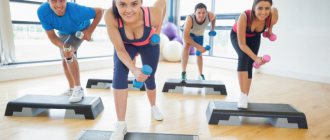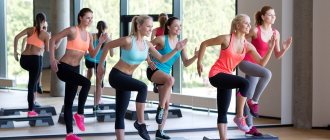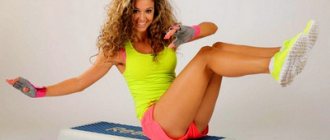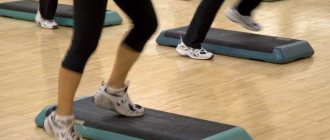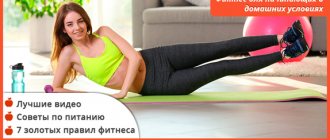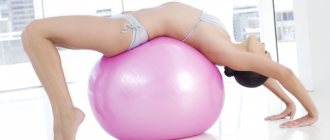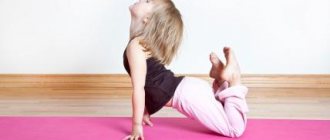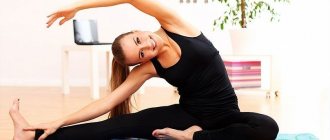If you want to achieve excellent posture, a slender waist and legs, a toned body, and increase its flexibility and coordination, then it’s hard to think of anything better than step aerobics.
Step aerobics is a type of aerobic (or cardio) training, the basis of which is steps to music and the use of a special sports equipment - step. A step is a small, sturdy platform that resembles a free-standing step or a low, short, wide bench. Its height can be changed, thereby individually adjusting the level of load in accordance with the preparedness and tastes of the training person.
Step aerobics movements
Step aerobics movements are built around going up and down from a step platform. In terms of intensity, they are equivalent to running at a speed of 12 km/h, but they allow you to get this load without running out of the gym. Basic movements are combined with additional sequences, often with dance elements (sometimes quite complex). The load on the shoulder girdle is provided by small dumbbells.
During step training, the muscles of the back and hips, calves and gluteal muscles work quite actively. But first of all, any cardio exercise is designed to strengthen the heart. Therefore, it is necessary to ensure that the pulse is in the “safe zone” during training. Step aerobics classes are usually carried out to music, the rhythm of which is about 130 beats per minute, which approximately corresponds to the average heart rate normal for such a workout.
Step training is a great way to burn extra calories. One lesson takes from 250 to 400 Kcal!
To practice alone, you don’t need anything special: anyone can buy a step platform or put together a bench and turn on music. However, as practice shows, nothing compares to the energy of group classes, so if you are just getting acquainted with step training, at least try visiting a fitness club - you will probably like it.
History of tap dance
Step aerobics was invented by US bodybuilding champion Gina Miller. After a knee injury, she could not return to her usual training for a long time, but her body and soul craved sports activities. Without thinking twice, Gina began training on the steps of the porch of her own house.
The athlete was so carried away by the exercises she had invented that she did not notice how the injury on her knee stopped bothering her, and the woman herself quickly regained her lost athletic form.
Technique
The secrets of the correct technique are not a secret, but practice shows that not everyone knows them:
- During exercise, you need to move gently, without jerking or straightening your knees sharply.
- When stepping onto the step and descending from it, you must avoid walking on your toes.
- Try to place your foot on the floor and the entire step platform.
- Avoid long steps when descending from the step, and lift using your legs, not your back.
- You need to keep your back straight, your breathing stable, and your stomach taut.
- Don't forget to work not only with your feet, but also with your hands.
Since the exercise is quite long and will literally make you sweat, drink a couple of glasses of clean water half an hour to an hour before training and keep a bottle nearby to quench your thirst between exercises.
Set of exercises
- Take the starting position: stand so that the step is directly in front of you, put your feet together. Now take a wide step to the right. Squat down slightly as you shift your weight onto your right leg. Then do the same on the other side. Take six steps in each direction.
- Take your starting position. Place your right foot on the step, then your left, and step down one by one. Now perform this exercise starting with your left leg. Repeat six lifts.
- Exercise number three is performed in exactly the same way as the second with only one difference - you need to stand on the step with your feet at shoulder width, that is, wider than in the first case. Six repetitions are required. When finishing the exercise, get off the step and stand sideways to it.
- From a position where the step is located on the side of you, place the foot closest to it on the step, and place the other leg on the step at a short distance. The leg with which you stepped on the platform should step on the floor first, while at the same time you perform a turn in such a way that you would be facing the step with the other side of your body. As with all previous exercises, six repetitions must be performed.
- Take a starting position similar to that in the previous exercise. Place the leg closest to the step in the middle of the platform, then lift the second leg onto the platform. Now we perform the descent from the opposite side of the step platform. This exercise must be repeated six times.
- Take starting position number one - standing in front of the step. Place your right foot on the step, swing your left foot forward and place it on the platform as well. Before lowering your right leg from the platform, do the same swing. Repeat this exercise starting with your left leg. Do six times.
- Stand directly in front of the step. Perform alternate lifting and lowering on your toes, while performing cross movements with your hands.
- Stand with your back to the step platform. Place your right foot on the step first, then your left. Perform this exercise in reverse order: lower your right leg from the platform, then your left. Do this exercise 6 times.
- Exercise number 9 is the same as exercise 8, with the only difference being that the descent from the platform is performed on the opposite side.
This set of step aerobics exercises will allow you to get rid of excess weight with pleasure, spending only half an hour a day.
Step aerobics classes
Each session usually begins with an introduction by the trainer and those present. The workout itself lasts about 45 minutes and is divided into several parts: WARM UP - a five-minute warm-up, during which you warm up your muscles with light exercise; PRE-STRETCH - preliminary stretching to prepare “sleeping” muscles and ligaments; CARDIO - the main aerobic part, work with a step platform, which takes up to 35 minutes; COOL DOWN - cool down, calm breathing and heart rate.
The main part of the lesson takes 20-30 minutes for beginners and 40-45 minutes for advanced ones. This is quite enough to get the much-needed physical activity for those losing weight.
There are several types of step. For beginners - a special low-intensity course. Having completed it, you can move on to high-intensity training. Their main difference is the duration of the aerobic part and the complexity of the steps.
Step platform
A platform raised on the ground is used as support during up and down stepping exercises. The height of the step platform is adjustable depending on the intensity. For beginners, for example, the step platform has only two height levels: 10 and 15 cm, and for advanced ones – 20 and 25 cm.
The surface of the step platform has a special coating that provides tight grip when moving back and forth and from side to side, which minimizes the risk of slipping and falling.
How to dress
A person in a tap dance class sweats a lot, so your clothes and shoes should be made of special breathable materials. We do not recommend buying items made from cotton or cotton and synthetics. They quickly become saturated with sweat and turn into a wet compress on the body. In addition, things made from natural fibers quickly lose their shape and fade after washing.
It is better to choose models made from high-tech “space” materials such as Tactel, Coolmax, Dry fit, Total or Supplex. (You will find the name of the material on the label.) Their “zest” is that they instantly absorb moisture and immediately evaporate it. It's hard to believe, but no matter how much you sweat, your body still remains dry.
You need to buy a T-shirt with a deep cut in the armpit, not a T-shirt. The latter will quickly become unusable from constant use of deodorant. It is better to choose a longer T-shirt - below the waist, so that, God forbid, your lower back does not get blown out if you find yourself under the air conditioner hood.
Women with large breasts should wear a special sports bra with a supportive effect under a T-shirt. Otherwise, your chest will sag from jumping. If you are in a sports store, ask the salesperson for advice. Today you can find tank tops and T-shirts with an elastic inner top that provides good support to the bust. However, we still recommend a sports bra for plus size women.
For step classes, you should wear breeches or short straight trousers. But it’s uncomfortable to train in wide trousers.
It is especially important to choose the right sneakers. There is no way to save on shoes, since almost all cheap models do not have arch supports.
Let's start with the fact that when doing step classes, running sneakers with thick, rigid soles and light sports slippers are contraindicated. Choose special sneakers for aerobics.
The last “squeak” is the forced foot ventilation system. We are talking about an elastic plastic lattice that is implanted into the sole. Aerobic running shoes come in high and low styles. You need tall ones. The specificity of step is that jumping overloads the ankle joint.
High-top sneakers tightly hug the ankle and thereby protect against injury. At first, you can train in low ones, but at an advanced level, where there are many complex choreographic elements, high sneakers are a must. Socks – only terry ones! They should be longer so that high-top sneakers do not rub your feet in the ankle area.
Immediately after finishing your workout, if you are going to continue training in the gym or another aerobics class, you should change your entire sportswear.
Benefits of classes
- This is a simple lesson, the choreography is more understandable than in aerobic dance classes.
- Interval step and workouts for beginners are suitable even for those who just want to increase their calorie expenditure, but do not dance and do not intend to study.
- In an hour in a non-boring environment, from 300 to 600 kcal are burned .
- Aerobic endurance and blood circulation improves.
This is an alternative to cardio training or aerobics without platforms. Anyone can learn; lessons are available in most fitness clubs and are held almost every evening. Training without strength training can easily be integrated into a weight loss program. For example, you can do strength exercises three times a week, and take step classes a couple of times. However, do not forget about the calorie deficit, otherwise no amount of exercise will help burn excess fat.
The lesson is suitable for any level of training. The higher the endurance, the greater the amplitude of steps can be. You can place the platform at a higher level and load the heart and leg muscles even more.
You can also train at home. Several classes are available in open sources. Experienced people love to improvise to music. You can watch a good program for practicing at home in this video:
A big plus for girls who do not want to build muscle mass is that the step tone their legs and buttocks, but does not increase muscle volume.
Exercises
For beginners who have not attended regular classes before, it is better to start with an appropriate group of basic movements: steps to the platform and back with a minimum of turns. This step class is called Step basic . A more advanced class of exercises, Step advanced , becomes available to those who are already able to withstand increased loads and perform more complex ligaments. This class is divided into two main types of classes: Dance step and Power step .
In the first, as you might guess, the emphasis is on complicating the dance movements, up to serious choreography. It will certainly appeal to those who like to attend raves and open airs and want to increase their endurance and find new moves. Moreover, not so long ago an interesting combination of Dance step with musical accompaniment in the drum'n'base genre appeared. Performing “steps” of high complexity and intensity to a broken beat is both more difficult and more interesting.
The name of the second type also speaks for itself. The main goal of the Power step is to alternate aerobic exercise with large volumes of strength exercises. In this way, you not only lose extra pounds, strengthen your heart, respiratory system, and shape your figure, but also seriously work out the muscles that you want to tighten.
Contraindications
Step aerobics is allowed for everyone except untrained people over fifty years of age and those for whom doctors have prohibited it. Everyone else can safely start classes. But you need to train correctly, otherwise the result will not be slimness and vigor, but fatigue and injury.
There is no question about whether you are for step aerobics or against it. Here are some facts from the world of step aerobics:
- Step aerobics is the most popular type of aerobic exercise in more than thirty countries around the world.
- Step aerobics has a beneficial effect on joints and posture. Regular exercise can prevent osteoporosis and arthritis, which usually occur due to lack of exercise.
- Step aerobics classes have a positive effect on the psyche no less than on the body. The percentage of depression and neuroses in those who train is sharply reduced.
- There are more than two hundred ways to get up and down from the platform.
- Increasing the height of the step by just five centimeters increases the load by 12%.
- According to statistics, for every thousand hours of step aerobics, there is only one injury.
- The effect of the classes becomes noticeable after just a month and a half of training!
There is nothing more pleasant than the feeling of muscles strained by training. Each one makes itself felt with languid fatigue, which will grow into strength and beauty. If you don’t dream of gaining an additional twenty kilograms of muscle, but simply want to gain excellent posture, a slender waist and legs, a toned body, and increase its plasticity and coordination, then it’s hard to think of anything better than step aerobics.
Contraindications for exercise
Training is not recommended if:
- varicose veins;
- hypermobility of the joints of the lower extremities;
- sports injuries and joint inflammation outside the rehabilitation period;
- dizziness, severe hypotension;
- high blood pressure during an exacerbation;
- any diseases of the heart and blood vessels, when it is recommended to exclude aerobic exercise.
Can pregnant women exercise? If the girl is experienced and knows the steps, is well oriented and feels normal, she can practice. A low impact class with no jumps will work quite well for this purpose. Exercising during pregnancy improves blood circulation and helps pregnancy. But if aerobic exercise is prohibited due to severe edema, pressure changes or uterine tone, it is better to postpone it.
Stepping is not recommended for people with significant obesity, which interferes with proper coordination of movements.
During steps, a significant load falls on the joints of the lower extremities. The greater your body weight, the greater the risk of cumulative injury. The ideal client for such a lesson is a person who is no more than 12 kg of excess weight.
© LIGHTFIELD STUDIOS — stock.adobe.com
